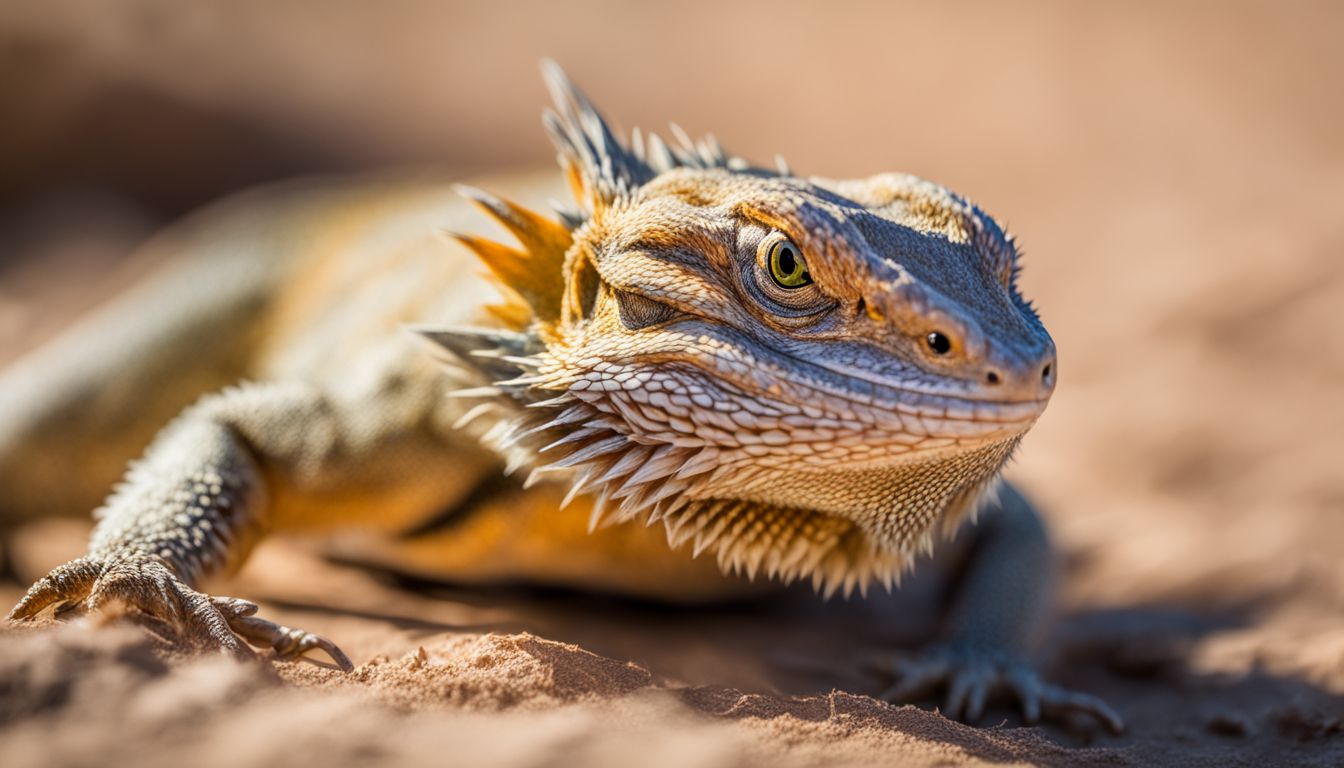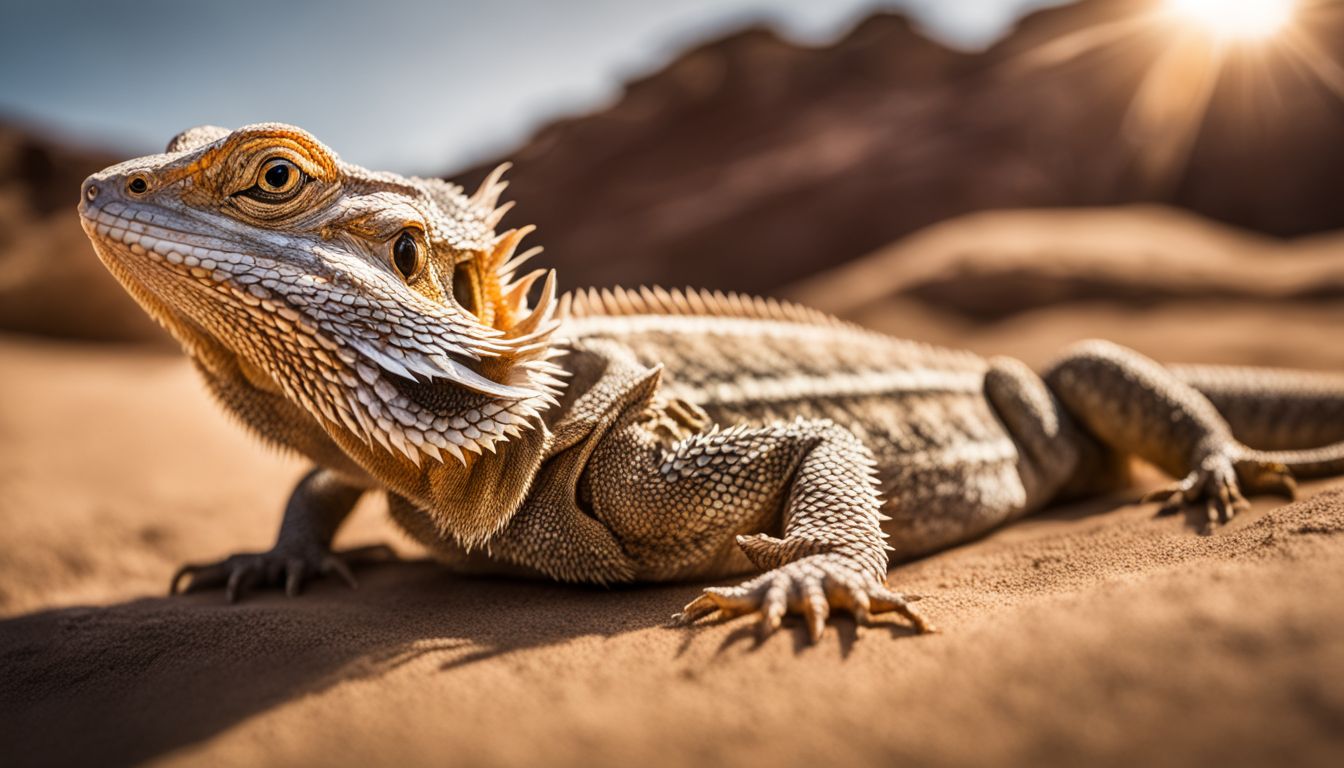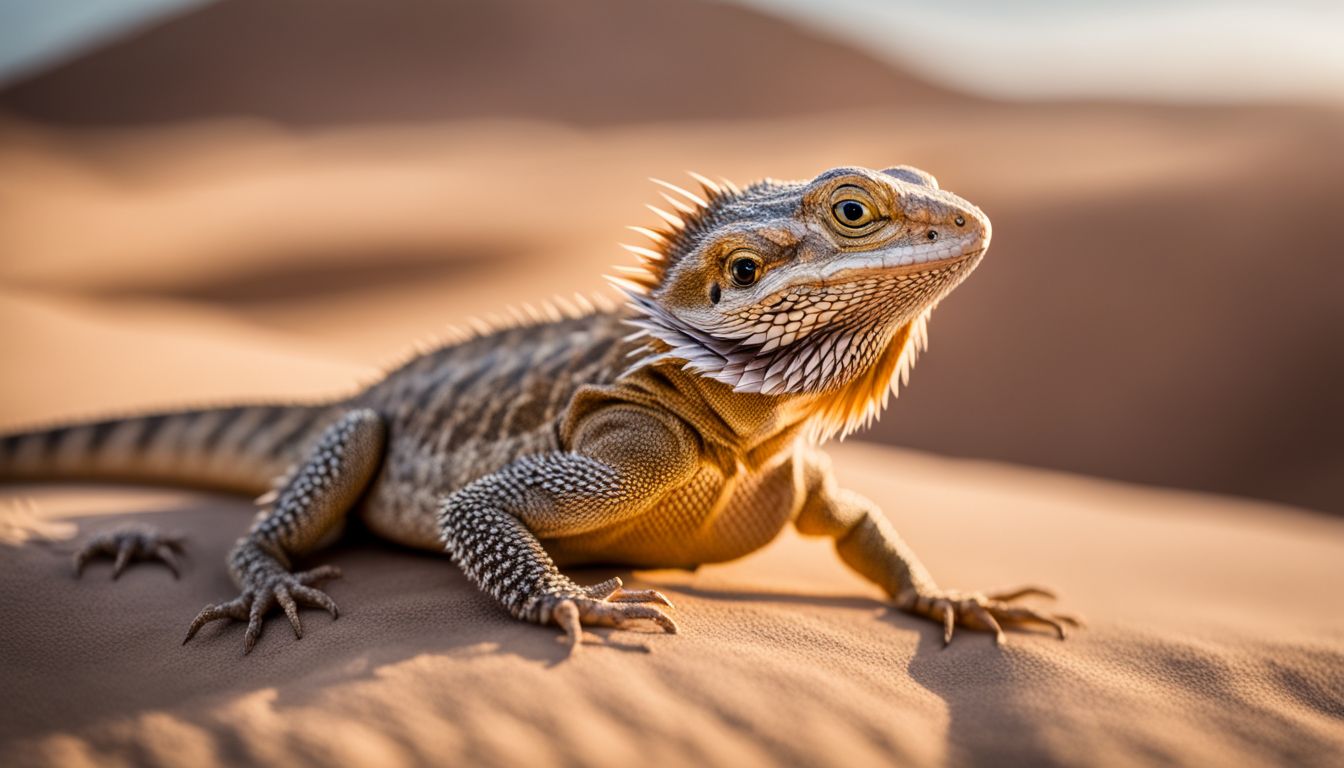Seeing your bearded dragon on its back can be alarming. These reptiles communicate through their beards, showing just how unique they are. Our article will guide you through understanding why this happens and what actions to take.
Let’s find out more!
Understanding Why Bearded Dragons Flip on Their Back

Bearded dragons may flip on their back due to various health issues such as infection, metabolic bone disease, atadenovirus, brain tumors, or head trauma. These factors can contribute to abnormal behaviors in bearded dragons.
Infection
Infections in bearded dragons can be serious. They might come from bacteria or fungus. One common bacterial infection is Salmonella, which is not just harmful to the dragon but also to children who handle them.
If your pet starts spinning in circles or tilting its head, these could be signs of illness. It’s crucial to watch for symptoms like these.
Expert veterinary care becomes essential if you suspect an infection. Fungal diseases need professional treatment as well. Knowing what health issues look like helps catch them early.
Next up, let’s dive into metabolic bone disease and how it affects your scaly friend.
Metabolic Bone Disease
Metabolic Bone Disease (MBD) hits bearded dragons hard, especially when their diet and habitat lack. This condition stems from a calcium deficiency, poor reptile nutrition, or not enough UVB lighting.
Think of it like the support beams in a house getting weak – without strong bones, a bearded dragon can’t uphold itself properly.
Recognizing early signs is crucial. Look out for weakened bones and trembling limbs. These symptoms show the urgent need for better care—think nutritional supplements rich in calcium and vitamin D3, plus proper UVB lighting to mimic sunshine.
It’s all about mimicking their natural environment to foster bone health and prevent MBD from turning your pet’s life upside down.
Atadenovirus
Atadenovirus hits bearded dragons hard. It’s a viral infection that messes with their digestive system, liver, and kidneys. Adult bearded dragons catch it and can get really sick—think liver disease, kidney issues, encephalitis, and bad stomach problems.
This virus is super contagious among reptiles. That means it spreads fast from one bearded dragon to another.
Keeping your beardie safe from atadenovirus takes work since there’s no magic cure once they’re sick. Some types of this virus even make them flip on their back because it affects their brain too—it’s pretty serious stuff.
People call this condition wasting disease or stargazing disease, and yes, it can lead to death if not caught early. Knowing about reptile viral infections helps you protect your scaly friend from getting really ill.
Next up, let’s talk about the signs that your bearded dragon might show when they’re not feeling well.
Brain Tumor
A brain tumor in a bearded dragon can lead to various neurological issues, including seizures and loss of coordination. These symptoms may cause the bearded dragon to flip on its back as a result of the impact on its brain health.
It’s important for novice reptile owners to be aware of this possibility and seek veterinary care if they notice any unusual behavior in their pet.
Some brain tumors can also present with stroke-like symptoms in bearded dragons, indicating potential neurological issues that require prompt attention. If a pet owner suspects their bearded dragon might have a brain tumor or is experiencing related symptoms, it’s crucial to consult a vet for proper diagnosis and guidance on treatment options based on these substantial facts about reptile care.
Head Trauma
Head trauma can lead to a bearded dragon flipping onto its back. This may cause neurological injury, affecting the brain and spinal cord. Signs of head trauma can include abnormal behavior, such as uncoordinated movements or seizures.
If you notice any unusual behavior in your bearded dragon, it’s essential to seek vet care promptly.
Understanding why bearded dragons flip on their back
The Meaning Behind a Bearded Dragon on Its Back

When a bearded dragon flips on its back, it may signify health issues such as hypocalcemia, vitamin D3 deficiency, dehydration, or loss of balance. This behavior can also be a defense mechanism when they feel threatened or stressed.
Hypocalcemia & Hypercalcemia
Hypocalcemia, or low calcium levels in bearded dragons, can lead to muscle tremors and seizures. This is often caused by a lack of dietary calcium or insufficient exposure to UVB light for proper vitamin D3 synthesis.
On the other hand, hypercalcemia, elevated calcium levels, may result from excessive supplementation or overexposure to UVB light. It can bring about symptoms like kidney damage and dehydration.
Monitoring your pet’s calcium balance through diet and exposure to UVB light is crucial for their overall health.
Understanding the signs of hypocalcemia and hypercalcemia in bearded dragons is essential knowledge for all reptile owners. Ensuring a properly balanced diet with adequate access to natural sunlight or artificial UVB lighting helps regulate their calcium metabolism, promoting healthy bone development and vital bodily functions.
Vitamin D3 Deficiency
Vitamin D3 deficiency in bearded dragons can lead to serious health issues. Without enough exposure to UV-B light, they may experience neurological problems causing them to flip onto their back.
This lack of vitamin D3 can also result in various other health complications for bearded dragons, making it crucial to ensure they receive adequate sunlight and vitamin D supplementation.
Inadequate vitamin D3 levels can weaken a bearded dragon’s immune system and lead to hypocalcemia, dehydration, and lethargy. It is essential for their bone health as well, since without sufficient vitamin D3, they are at risk of developing metabolic bone disease or osteoporosis.
Dehydration
Inadequate hydration can lead to serious health issues for bearded dragons. Dehydration is common in these desert-dwelling reptiles due to factors such as a lack of access to water, low-moisture diets, and insufficient environmental humidity.
Signs of dehydration include lethargy, sunken eyes, and retained shedding. To combat this issue, ensure your pet beardie has constant access to fresh water and consider periodic misting or bathing sessions to maintain proper hydration levels.
Loss of Balance
Bearded dragons can experience unsteadiness, dizziness, and weakness in their legs due to conditions like dehydration or metabolic bone disease. Shaking, a head tilt, or flipping over are red flags for potential health issues in bearded dragons.
Factors such as hypocalcemia, hypercalcemia, and vitamin D3 deficiency can lead to loss of balance in these reptiles. If your bearded dragon is showing signs of imbalance, it’s crucial to seek immediate veterinary attention to address any underlying health concerns.
Recognizing the signs of imbalance in your bearded dragon is essential for maintaining its well-being. When you notice symptoms such as unsteadiness or lightheadedness, prompt action is necessary to ensure the best care for your pet reptile.
Defense Mechanism
Bearded dragons use their body language to protect themselves from danger. When scared or threatened, they puff out their beard and display defensive posturing by puffing up their body.
Their body spikes also serve as a protective measure against potential predators. These fear-induced reactions help them avoid predators and survive in the wild.
To show fear and protect themselves, bearded dragons have developed various defense strategies including camouflage techniques such as remaining close to rock piles for protection and hiding.
What to Do If Your Bearded Dragon is on Its Back
If your bearded dragon is on its back, immediately check for signs of distress and gently turn it over. Monitor its behavior closely and seek veterinary care if you notice any abnormal symptoms or if your pet continues to flip onto its back.
Recognizing Signs of Illness
Bearded dragons may show signs of illness through specific symptoms such as swelling in the jaw or hind limbs, dark spots on their chin, neck, and belly, diarrhea, vomiting, lack of appetite, lethargy, wheezing, gasping, coughing, and discharge from the eyes and ears.
Observing their awareness level, posture, skin color, injuries if any.. can help identify signs of distress. Additionally,.. high parasite counts may manifest as diarrhea,.. indicating illness.
Keeping an eye out for these cues can aid in catching potential health issues early.
When to Consult a Vet
If your bearded dragon shows signs of illness such as weakness in limbs, seizures, or swelling of the jaw or hind limbs, it’s crucial to seek veterinary attention. These could indicate serious conditions like calcium deficiency or metabolic bone disease, which require prompt intervention by a reptile veterinarian familiar with bearded dragon health.
It’s important not to delay seeking expert care when you notice these concerning symptoms in your pet.
Remember to monitor for any unusual behavior that may signal an underlying health issue. If you observe your bearded dragon displaying distressing symptoms like falling on its back, veterinary consultation is necessary for proper diagnosis and treatment.
Conclusion
If you find your bearded dragon on its back, it could signal a health issue. Look for signs of illness and consult a vet promptly if needed. Take action to help keep your reptile friend healthy and happy! Remember, proper care is crucial for the well-being of your bearded dragon.
For more tips on keeping your bearded dragon happy and healthy, check out our guide on whether bearded dragons can eat apricots.
FAQs
1. Can bearded dragons lay on their backs?
Yes, bearded dragons can occasionally lay on their backs as a natural behavior, but prolonged back laying may indicate health issues and should be monitored.
2. What does it mean if my bearded dragon is lying on its back?
If your bearded dragon is lying on its back, it could signify discomfort or illness, and you should observe for any signs of distress or abnormal behavior.
3. How do I safely handle a bearded dragon that’s on its back?
To handle a bearded dragon that’s on its back, carefully roll them onto their stomach using gentle movements to avoid causing stress or injury.
4. Is it normal for baby bearded dragons to lie on their backs frequently?
Baby bearded dragons may sometimes lie on their backs more often than adults due to exploring behaviors and growth development; however, consistent back laying should still warrant attention.
5. When should I seek veterinary help if my bearded dragon lays on its back?
If your bearded dragon exhibits unusual or persistent behavior such as laying on its back, seeking veterinary advice promptly is recommended to ensure the reptile’s well-being.




